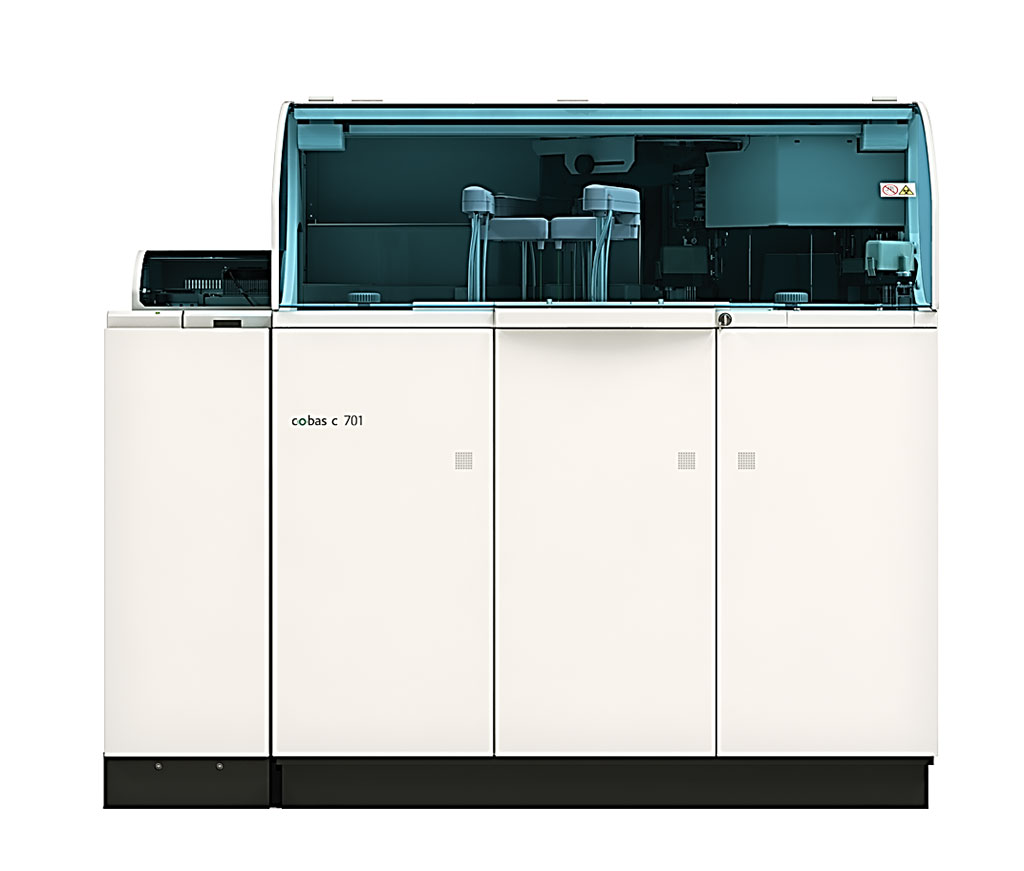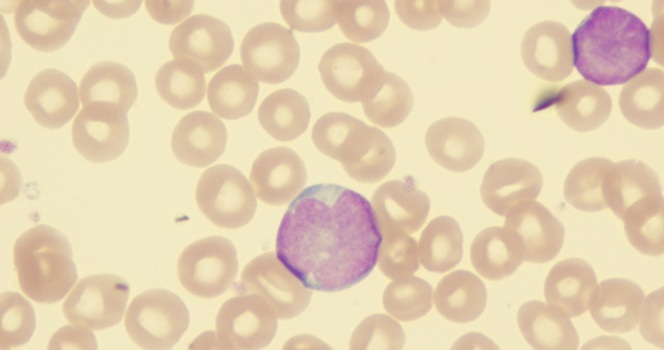Serum α-L-Fucosidase Activity Measured for COVID-19 Infection
|
By LabMedica International staff writers Posted on 22 Apr 2021 |

Image: The cobas c 701 module is a high throughput clinical chemistry module that performs photometric assay tests for a wide range of analytes (Photo courtesy of Roche Diagnostics)
An unusual fucosylated LacdiNAc in the receptor-binding domains of the spike protein of COVID-19 has been observed. Reduced fucosylation was also found in a specific Fc domain of IgG antibodies in COVID-19 patients that enhanced the interactions with the activating FcγR, FcγRIIIa.
α-L-fucosidase is the enzyme used to catalyze the hydrolytic removal of L-fucose from the fucosylated glycans in the glycoproteins and glycolipids. Removal of fucose from the airway mucus not only impaired the wound closure of the airway, but also regulated the function of immune cells to defense against bacteria and viruses.
Medical Laboratorians at the University of Chinese Medicine (Guangzhou, China) included 585 COVID-19 patients from December 26, 2019, to March 9, 2020, to analyze the correlations of α-L-fucosidase activity with the nucleic acid test, IgM/IgG, comorbidities, and disease progression. An automated hematology analyzer was used to perform blood count (Sysmex Corporation, Kobe, Japan). Analysis of peripheral blood lymphocyte subsets was performed by BD FACSCanto II (Becton, Dickinson, and Company, Franklin Lakes, NJ, USA).
The clinical biochemical analytes were measured on a Roche Cobas 701 (Roche Diagnostics, Rotkreuz, Switzerland). In particular, the serum amyloid (SAA) and C-reactive protein (CRP) measurements were performed based on latex immunoturbidimetry. The serum α-L-fucosidase activity was quantified using MG-2-chloro-4-nitrobenzene-α-L-fucoside (CNPF) as the substrate (Maccura Biotechnology Co., Ltd, Chengdu, China) on a Roche Cobas 701.
The scientists reported that among the COVID-19 patients, 5.75% were double-negative for nucleic acid and antibodies. All of them had increased α-L-fucosidase, while only one had abnormal serum amyloid A (SAA) and C-reactive protein (CRP). The abnormal rate of α-L-fucosidase was 81.82% before the presence of IgM, 100% in the presence of IgM, and 66.2% in the presence of IgG. The team noted that 73.42% of patients with glucometabolic disorders had increased α-L-fucosidase activity and had the highest mortality of 6.33%. The increased α-L-fucosidase was observed in 55.8% of non-severe cases and 72.9% of severe cases, with an odds ratio of 2.12. The α-L-fucosidase mRNA was irrelevant to its serum activity.
The authors concluded that the change in α-L-fucosidase activity in COVID-19 preceded the IgM and SAA and showed a preferable relation with glucometabolic disorders, which may be conducive to virus invasion or invoke an immune response against SARS-CoV-2. The study was published on April 5, 2021 in the journal Clinica Chimica Acta.
Related Links:
University of Chinese Medicine
Sysmex Corporation
Becton, Dickinson, and Company
Roche Diagnostics
Maccura Biotechnology Co
α-L-fucosidase is the enzyme used to catalyze the hydrolytic removal of L-fucose from the fucosylated glycans in the glycoproteins and glycolipids. Removal of fucose from the airway mucus not only impaired the wound closure of the airway, but also regulated the function of immune cells to defense against bacteria and viruses.
Medical Laboratorians at the University of Chinese Medicine (Guangzhou, China) included 585 COVID-19 patients from December 26, 2019, to March 9, 2020, to analyze the correlations of α-L-fucosidase activity with the nucleic acid test, IgM/IgG, comorbidities, and disease progression. An automated hematology analyzer was used to perform blood count (Sysmex Corporation, Kobe, Japan). Analysis of peripheral blood lymphocyte subsets was performed by BD FACSCanto II (Becton, Dickinson, and Company, Franklin Lakes, NJ, USA).
The clinical biochemical analytes were measured on a Roche Cobas 701 (Roche Diagnostics, Rotkreuz, Switzerland). In particular, the serum amyloid (SAA) and C-reactive protein (CRP) measurements were performed based on latex immunoturbidimetry. The serum α-L-fucosidase activity was quantified using MG-2-chloro-4-nitrobenzene-α-L-fucoside (CNPF) as the substrate (Maccura Biotechnology Co., Ltd, Chengdu, China) on a Roche Cobas 701.
The scientists reported that among the COVID-19 patients, 5.75% were double-negative for nucleic acid and antibodies. All of them had increased α-L-fucosidase, while only one had abnormal serum amyloid A (SAA) and C-reactive protein (CRP). The abnormal rate of α-L-fucosidase was 81.82% before the presence of IgM, 100% in the presence of IgM, and 66.2% in the presence of IgG. The team noted that 73.42% of patients with glucometabolic disorders had increased α-L-fucosidase activity and had the highest mortality of 6.33%. The increased α-L-fucosidase was observed in 55.8% of non-severe cases and 72.9% of severe cases, with an odds ratio of 2.12. The α-L-fucosidase mRNA was irrelevant to its serum activity.
The authors concluded that the change in α-L-fucosidase activity in COVID-19 preceded the IgM and SAA and showed a preferable relation with glucometabolic disorders, which may be conducive to virus invasion or invoke an immune response against SARS-CoV-2. The study was published on April 5, 2021 in the journal Clinica Chimica Acta.
Related Links:
University of Chinese Medicine
Sysmex Corporation
Becton, Dickinson, and Company
Roche Diagnostics
Maccura Biotechnology Co
Latest Microbiology News
- Rapid Diagnostic Test Matches Gold Standard for Sepsis Detection
- Rapid POC Tuberculosis Test Provides Results Within 15 Minutes
- Rapid Assay Identifies Bloodstream Infection Pathogens Directly from Patient Samples
- Blood-Based Molecular Signatures to Enable Rapid EPTB Diagnosis
- 15-Minute Blood Test Diagnoses Life-Threatening Infections in Children
- High-Throughput Enteric Panels Detect Multiple GI Bacterial Infections from Single Stool Swab Sample
- Fast Noninvasive Bedside Test Uses Sugar Fingerprint to Detect Fungal Infections
- Rapid Sepsis Diagnostic Device to Enable Personalized Critical Care for ICU Patients
- Microfluidic Platform Assesses Neutrophil Function in Sepsis Patients
- New Diagnostic Method Confirms Sepsis Infections Earlier
- New Markers Could Predict Risk of Severe Chlamydia Infection
- Portable Spectroscopy Rapidly and Noninvasively Detects Bacterial Species in Vaginal Fluid
- CRISPR-Based Saliva Test Detects Tuberculosis Directly from Sputum
- Urine-Based Assay Diagnoses Common Lung Infection in Immunocompromised People
- Saliva Test Detects Implant-Related Microbial Risks
- New Platform Leverages AI and Quantum Computing to Predict Salmonella Antimicrobial Resistance
Channels
Molecular Diagnostics
view channel
Simple Urine Test to Revolutionize Bladder Cancer Diagnosis and Treatment
Bladder cancer is one of the most common and deadly urological cancers and is marked by a high rate of recurrence. Diagnosis and follow-up still rely heavily on invasive cystoscopy or urine cytology, which... Read more
Blood Test to Enable Earlier and Simpler Detection of Liver Fibrosis
Persistent liver damage caused by alcohol misuse or viral infections can trigger liver fibrosis, a condition in which healthy tissue is gradually replaced by collagen fibers. Even after successful treatment... Read moreHematology
view channel
Platelet Activity Blood Test in Middle Age Could Identify Early Alzheimer’s Risk
Early detection of Alzheimer’s disease remains one of the biggest unmet needs in neurology, particularly because the biological changes underlying the disorder begin decades before memory symptoms appear.... Read more
Microvesicles Measurement Could Detect Vascular Injury in Sickle Cell Disease Patients
Assessing disease severity in sickle cell disease (SCD) remains challenging, especially when trying to predict hemolysis, vascular injury, and risk of complications such as vaso-occlusive crises.... Read more
ADLM’s New Coagulation Testing Guidance to Improve Care for Patients on Blood Thinners
Direct oral anticoagulants (DOACs) are one of the most common types of blood thinners. Patients take them to prevent a host of complications that could arise from blood clotting, including stroke, deep... Read moreImmunology
view channel
New Test Distinguishes Vaccine-Induced False Positives from Active HIV Infection
Since HIV was identified in 1983, more than 91 million people have contracted the virus, and over 44 million have died from related causes. Today, nearly 40 million individuals worldwide live with HIV-1,... Read more
Gene Signature Test Predicts Response to Key Breast Cancer Treatment
DK4/6 inhibitors paired with hormone therapy have become a cornerstone treatment for advanced HR+/HER2– breast cancer, slowing tumor growth by blocking key proteins that drive cell division.... Read more
Chip Captures Cancer Cells from Blood to Help Select Right Breast Cancer Treatment
Ductal carcinoma in situ (DCIS) accounts for about a quarter of all breast cancer cases and generally carries a good prognosis. This non-invasive form of the disease may or may not become life-threatening.... Read moreMicrobiology
view channel
Rapid Diagnostic Test Matches Gold Standard for Sepsis Detection
Sepsis kills 11 million people worldwide every year and generates massive healthcare costs. In the USA and Europe alone, sepsis accounts for USD 100 billion in annual hospitalization expenses.... Read moreRapid POC Tuberculosis Test Provides Results Within 15 Minutes
Tuberculosis remains one of the world’s deadliest infectious diseases, and reducing new cases depends on identifying individuals with latent infection before it progresses. Current diagnostic tools often... Read more
Rapid Assay Identifies Bloodstream Infection Pathogens Directly from Patient Samples
Bloodstream infections in sepsis progress quickly and demand rapid, precise diagnosis. Current blood-culture methods often take one to five days to identify the pathogen, leaving clinicians to treat blindly... Read morePathology
view channel
Tunable Cell-Sorting Device Holds Potential for Multiple Biomedical Applications
Isolating rare cancer cells from blood is essential for diagnosing metastasis and guiding treatment decisions, but remains technically challenging. Many existing techniques struggle to balance accuracy,... Read moreAI Tool Outperforms Doctors in Spotting Blood Cell Abnormalities
Diagnosing blood disorders depends on recognizing subtle abnormalities in cell size, shape, and structure, yet this process is slow, subjective, and requires years of expert training. Even specialists... Read moreTechnology
view channel
Artificial Intelligence Model Could Accelerate Rare Disease Diagnosis
Identifying which genetic variants actually cause disease remains one of the biggest challenges in genomic medicine. Each person carries tens of thousands of DNA changes, yet only a few meaningfully alter... Read more
AI Saliva Sensor Enables Early Detection of Head and Neck Cancer
Early detection of head and neck cancer remains difficult because the disease produces few or no symptoms in its earliest stages, and lesions often lie deep within the head or neck, where biopsy or endoscopy... Read moreIndustry
view channel
Abbott Acquires Cancer-Screening Company Exact Sciences
Abbott (Abbott Park, IL, USA) has entered into a definitive agreement to acquire Exact Sciences (Madison, WI, USA), enabling it to enter and lead in fast-growing cancer diagnostics segments.... Read more









 Analyzer.jpg)












